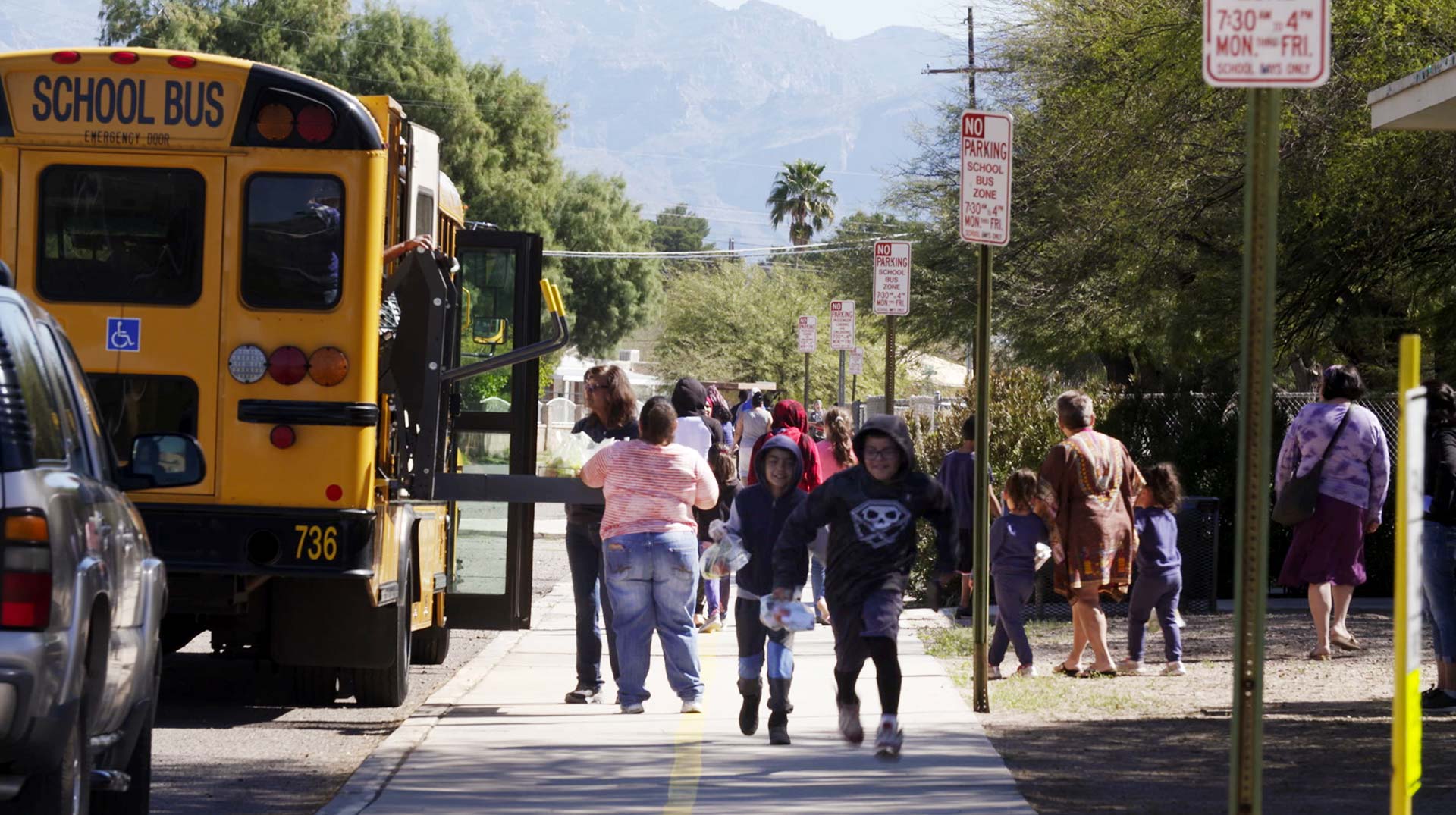 Students and families receive packaged meals from Tucson Unified School District workers who are distributing meals along the district's bus routes during closures associated with the COVID-19 pandemic.
Students and families receive packaged meals from Tucson Unified School District workers who are distributing meals along the district's bus routes during closures associated with the COVID-19 pandemic.
Listen to Part I
Listen to Part II
During the pandemic, federal relief helped Tucson Unified School District survive an unprecedented crisis. The money, more than $267 million, allowed the district to build an online learning platform, provide tablets to over 40,000 students, and hire hundreds of staff to help children recover from lost classroom time.
But that money was never meant to last forever. And now it’s gone.
Nearly $27 million of the relief was used to assist academic recovery for positions like classroom aides, interventionists, and reading specialists. TUSD Superintendent Gabriel Trujillo says the goal was to give students personalized support, especially in the lower grades, where early reading skills are essential.
At Miles Exploratory Learning Center, 8-year-old Ariah Carlson is spending her summer in a reading recovery class.
“I like it here,” she said. “Because when the whole class raises their hand, sometimes I don’t get picked to answer the question, and I really wanted to answer the question.”
Her teacher, Alice Richter, says many children returned from remote learning without knowing basic letter sounds. The federal dollars, better known as ESSER, helped fill those gaps.
“With ESSER funding ending, they’re pulling a lot of reading specialists,” Richter said. “I didn’t even know if I was going to have a job at my school for the following year.”
The loss of funding has forced the district to make difficult choices. While officials cut more than $8 million from administrative costs, they’ve also had to pause teacher raises and cut back on classroom support staff, like the aides who helped teachers give more focused attention to struggling students.
“If that teacher's assistant is out of the room, you are not able to effectively differentiate your instruction,” Trujillo said. “Now you're faced with a group of 30 and primarily your role then is just becoming classroom management and managing the logistics of a large group, versus when a teacher's assistant is in there, you can actually get in and differentiate your instruction.”
Other districts are now offering more competitive salaries—up to $65,000 in some cases —while TUSD is still at $58,000, according to the superintendent. Trujillo warns that without the ability to raise pay, the district risks losing more experienced teachers to neighboring schools.
“It's a matter of life and death in terms of being able to compete for the best possible teaching talent,” he said.
TUSD also used COVID funding to expand access to music, art, and athletics, hiring 14 full-time arts teachers.
However, when budget tightening comes along, arts programs are usually thought of to be the first that should be downsized. That’s a decision that TUSD chose not to do.
“It’s difficult because we know that kids who participate in the fine arts do better academically,” TUSD Chief Financial Office Ricky Hernandez said.
With a multi-million-dollar deficit that needs to be closed, TUSD is facing tough choices. In many ways, it is like “whack a mole,” according to Hernandez.
“It’s ridiculous that we have to rely on a once-in-a-lifetime infusion of funds to do right by the children of this district,” Trujillo said.
Now, the district is asking voters to approve a $45 million budget override this fall, funded by a local property tax increase. If passed, it would help fund raises, preserve academic and arts programs, and give the district time to plan for long-term sustainability. The override would last seven years, gradually decreasing in its final two.
“The override is about showing the community what this kind of investment can do,” TUSD Chief Financial Officer Ricky Hernandez said.
But convincing voters won’t be easy. The last time TUSD asked for a similar measure was in 2009. Voters rejected it.
Still, Tucson isn’t alone. Across Arizona, school districts are grappling with the end of pandemic relief and a funding system that was already strained before COVID hit. Education expert Roseanne Lopez says most districts are being forced to increase class sizes, lay off staff or cut services.
“If you’re not getting an equal inflationary share from the state… you’re going to have to cut back,” she said. “There is no other way.”
For teachers like Richter, the impact is clear in the classroom. Fewer aides and specialists mean fewer students get the help they need and fewer teachers get the support to do their jobs well.
“They're really crucial so that the teachers can do their jobs,” Richter said.
And for students like Ariah, those differences matter.
Whether voters support the override this fall could determine if the progress made in the wake of the pandemic continues or disappears with the funding that made it possible.

By submitting your comments, you hereby give AZPM the right to post your comments and potentially use them in any other form of media operated by this institution.